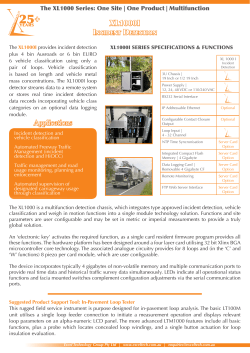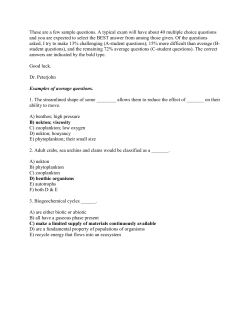
File
Pharmacology – I [PHL 313] Diuretics Dr. Mohammad Nazam Ansari Renal Pharmacology Kidneys: • Each adult kidney weighs 125-170g in males and 115155g in females, represent 0.5% of total body weight, but receive ~25% of the total arterial blood pumped by the heart • Each kidney contains 1-2 million nephrons: – The glomerulus – The proximal convoluted tubule – The loop of Henle – The distal convoluted tubule The formation of urine • In summary, three processes occurring in successive portions of the nephron accomplish the function of urine formation: – Filtration of water and dissolved substances out of the blood in the glomeruli and into Bowman's capsule; – Reabsorption of water and dissolved substances out of the kidney tubules back into the blood (note that this process prevents substances needed by the body from being lost in the urine); – Secretion of hydrogen ions (H+), potassium ions (K+), ammonia (NH3), and certain drugs out of the blood and into the kidney tubules, where they are eventually eliminated in the urine. Diuretics • DIURESIS: increased urine flow • DIURETICS: substances which elicit diuresis • In the kidney, water reabsorption dependent primarily on Na+ reabsorption • Thus, a diuretic is an agent which inhibits tubular Na+ reabsorption (along with Cl-, HCO3-), at one or more sites in nephron, resulting in increased excretion of these ions. • Natriuretic effect (enhance secretion of sodium and thus water) • Diuretics can have effects on: - Sodium reabsorption - Potassium loss - Body fluids Background • Certain disease states may cause blood volume to increase outside of narrowly defined limits – Hypertension – Congestive heart failure – Liver cirrhosis – Nephrotic syndrome – Renal failure • Dietary Na restriction often not enough to maintain ECF and prevent edema diuretics needed • Primary effect of diuretics is to increase solute excretion, mainly as NaCl • Diuretics causes increase in urine volume due to increased osmotic pressure in lumen of renal tubule and concomitant decrease in extra-cellular volume (blood volume) Classification The different classes and key prototypes of diuretics include: • Osmotic diuretics: – Mannitol • Carbonic anhydrase inhibitors: – Acetozolamide • Loop diuretics or the high ceiling diuretics: – Furosemide, Torsemide, Bumetanide, Ethacrynic acid • Thiazide and thiazide-like diuretics: – Hydrochlorothiazide, Chlorthalodone, chlorothiazide, Metolazone • K+ sparing diuretics: – Na channel inhibitors: amiloride, triamterene – Aldosterone receptor antagonists: spironolactone, eplerenone Nephron: sites of action of diuretics Osmotic diuretics • Therapeutic Uses: – Acute renal failure – Reduce preoperative intraocular or intracranial pressure • No interaction with transport systems • Consequently solutes remain within the filtrate and exert an osmotic effect that inhibits the reabsorption of water. – This effect can also be seen if blood plasma levels of glucose become very high (e.g. in hyperglycaemic episodes experienced by individuals with diabetes mellitus). The glucose that remains unabsorbed inhibits the reabsorption of water and larger volumes of urine are typically produced, initially. • All activity depends on osmotic pressure exerted in lumen • Blocks water reabsorption in PCT & descending loop of Henle • Results in large water loss, smaller electrolyte loss can result in hypernatremia Carbonic anhydrase inhibitors: work in PCT Example: Acetazolamide • Acts to block carbonic anhydrase (CA), • CAIs work on co-transport of Na+, HCO3- and Cl- that is coupled to H+ counter-transport 1. CA converts HCO3- + H+ to H2O + CO2 in tubular lumen 2. CO2 diffuses into cell (water follows Na+), CA converts CO2 + H2O into HCO3- + H+ 3. H+ now available again for counter-transport with Na+, etc) 4. Na+ and HCO3- now transported into peritubular capillary • CA can catalyze reaction in either direction depending on relative concentration of substrates Therapeutic Uses – Cystinuria (increase alkalinity of tubular urine) – Glaucoma (decrease ocular pressure) – Acute mountain sickness – Metabolic alkalosis Na-K-2Cl SYMPORT INHIBITORS Also Called: •Loop Diuretics •High Ceiling Diuretics Ethacrynic Acid Furosemide (LASIX) (EDECRIN) Bumetanide Torsemide (BUMEX) (DEMADEX) MOA: Loop diuretics • No transport systems in descending loop of Henle • Ascending loop contains Na+ - K+ - 2Cl- co-transporter from lumen to ascending limb cells • Loop diuretic blocks co-transporter Na+, K+, and Cl- remain in lumen, excreted along with water Loop diuretics (ascending limb of loop) • Generally cause greater diuresis than thiazides; used when they are insufficient • Can enhance Ca2+ and Mg2+ excretion Therapeutic uses: – Hypertension, in patients with impaired renal function – Congestive heart failure (moderate to severe) – Acute pulmonary edema – Chronic or acute renal failure – Nephrotic syndrome – Hyperkalemia – Chemical intoxication (to increase urine flow) THERAPEUTIC EFFECTS Increase Na Excretion to 25% of Filtered Load Treatment for Severe Edema Increase Urine Volume Treatment for Oliguric Acute Renal Failure Increase Ca Excretion Treatment for Hypercalcemia Impair Free Water Reabsorption Treatment for Hyponatremia Increase Venous Capacitance Treatment for Pulmonary Edema ADVERSE EFFECTS Profound ECFV Depletion Metabolic Alkalosis Hypokalemia Ototoxicity Hypocalcemia Hyperuricemia Hypomagnesemia Hyperglycemia Na-Cl SYMPORT INHIBITORS Also Called: •Thiazide Diuretics •Thiazide-Like Diuretics Hydrochlorothiazide (HYDRODIURIL) Chlorthalidone (HYGROTON) Chlorothiazide Metolazone (DIURIL) (ZAROXOLYN) MOA: Thiazide Diuretics in the DCT • Less reabsorption of water and electrolytes in the distal convoluted tubule than proximal tubule or loop • A Na+-Cl- co-transporter there is blocked by thiazides Thiazide diuretics (DCT) • Magnitude of effect is lower because work on distal convoluted tubule (only receives 15% of filtrate) • Cause decreased Ca excretion hypercalcemia reduce osteoporosis • Therapeutic uses – Hypertension – Edema (Cardiac, hepatic, Renal) – Congestive heart failure (mild) – Renal calculi – Nephrogenic diabetes insipidus – Chronic renal failure (as an adjunct to loop diuretic) – Osteoporosis THERAPEUTIC EFFECTS Increase Na Excretion to 5% of Filtered Load Treatment for Mild Edema Decrease Ca Excretion Treatment for Hypertension Treatment for Nephrogenic Diabetes Insipidus Treatment for Calcium Nephrolithiasis ADVERSE EFFECTS ECFV Depletion Impotence Hypokalemia Metabolic Alkalosis Hyponatremia Increased LDL Hypomagnesemia Hypercalcemia Hyperglycemia Hyperuricemia Na CHANNEL INHIBITORS Also Called: •K-Sparing Diuretics Triamterene (DYRENIUM) Amiloride (MIDAMOR) MOA: Two cell types in collecting tubule 1. Principal cells – transport Na, K, water 2. Intercalated cells – secretion of H+ and HCO3 3. Blocking Na+ movement in also prevents K+ movement out Potassium-sparing diuretics (collecting tubule) • Reduce K loss by inhibiting Na/K exchange • Not a strong diuretic because Have most downstream site of action (collecting tubule) • Often used in combination with thiazide diuretics to restrict K loss • Therapeutic uses – Chronic liver failure – Congestive heart failure, when hypokalemia is a problem THERAPEUTIC EFFECTS Enhance Natriuresis Caused by Other Diuretics Prevent Hypokalemia Used in Combination with Loop & Thiazide Diuretics Block Na Channels Treatment for Liddle’s Syndrome Treatment for Lithium-Induced Diabetes Insipidus ADVERSE EFFECTS Amiloride Triamterene Hyperkalemia Hyperkalemia Renal Stones Interstitial Nephritis Megaloblastosis MINERALOCORTICOID RECEPTOR ANTAGONISTS Also Called: •K-Sparing Diuretics •Aldosterone Antagonists Spironolactone (ALDACTONE) Eplerenone (INSPRA) (Syndrome of Apparent MC excess) (Licorice: Glycyrrhizic Acid) THERAPEUTIC EFFECTS Enhances Natriuresis Caused by Other Diuretics Used in Combination with Loop & Thiazide Diuretics Prevents Hypokalemia Blocks Aldosterone Treatment for Primary Hyperaldosteronism Treatment for Heart Failure Treatment for Edema of Liver Cirrhosis Treatment for Hypertension ADVERSE EFFECTS Hyperkalemia Metabolic Acidosis Gastritis Peptic Ulcers Impotence Deepening of Voice CNS Side Effects Gynecomastia Hirsutism Menstrual Irregularities Types and Names of Diuretics Type Example Sites of Action Osmotic agents Mannitol PCT Descending loop Carbonic anhydrase inhibitors. Acetazolamide PCT Loop diuretic Ethacrynic acid Furosemide Loop of Henle Thiazides Hydrochlorothiazide DCT K+ - sparing Spironolactone Amiloride Collecting tubule Thank you
© Copyright 2025









